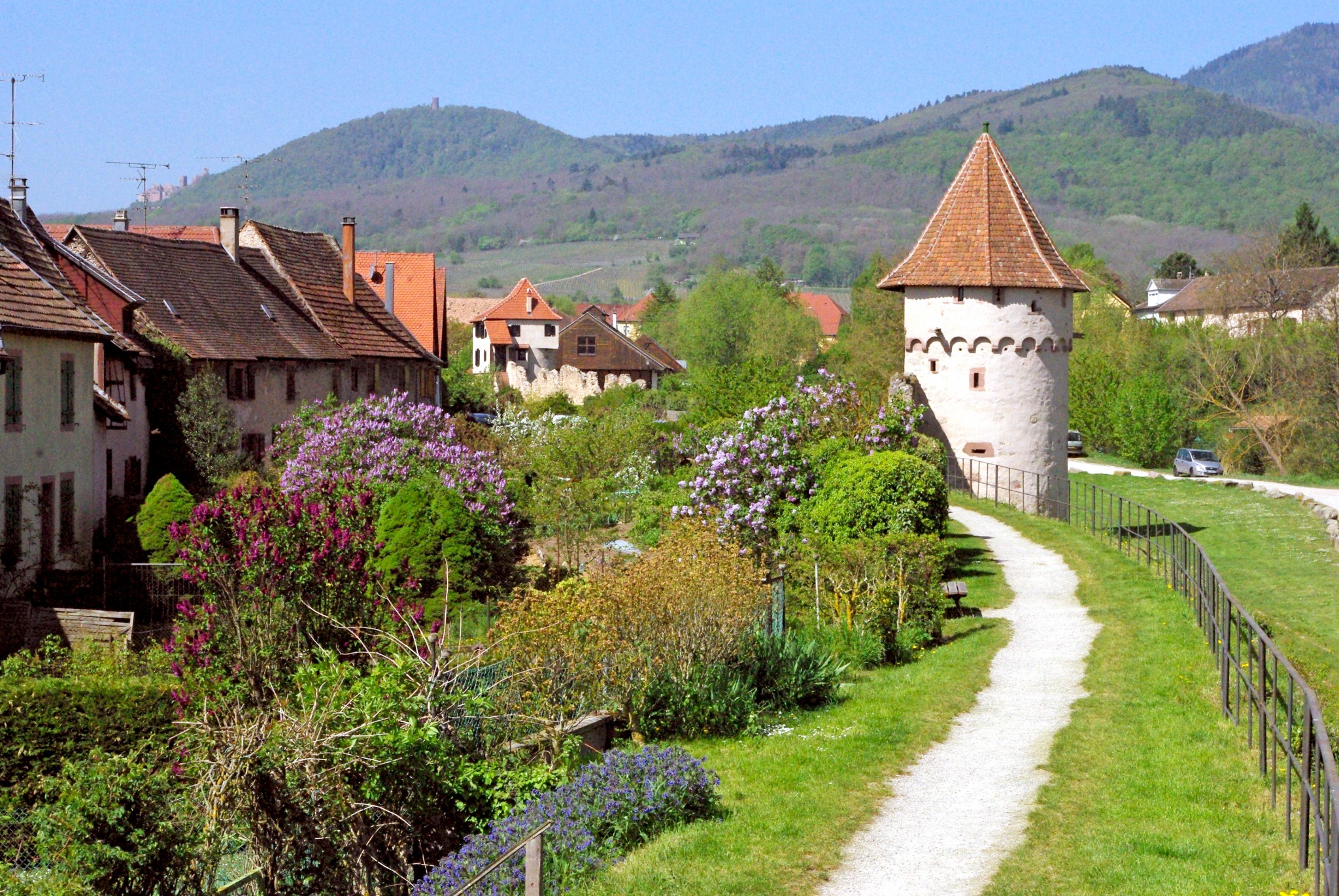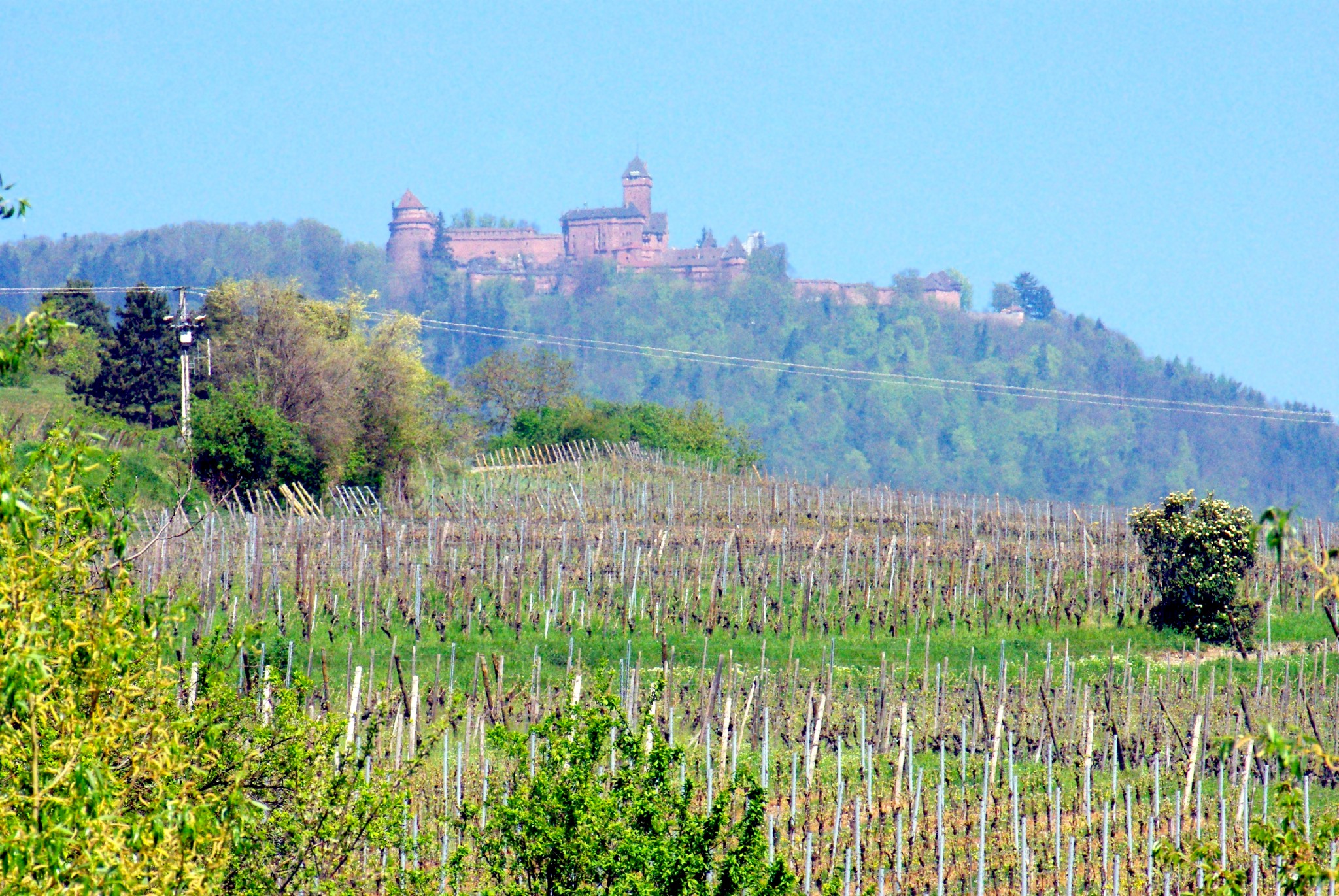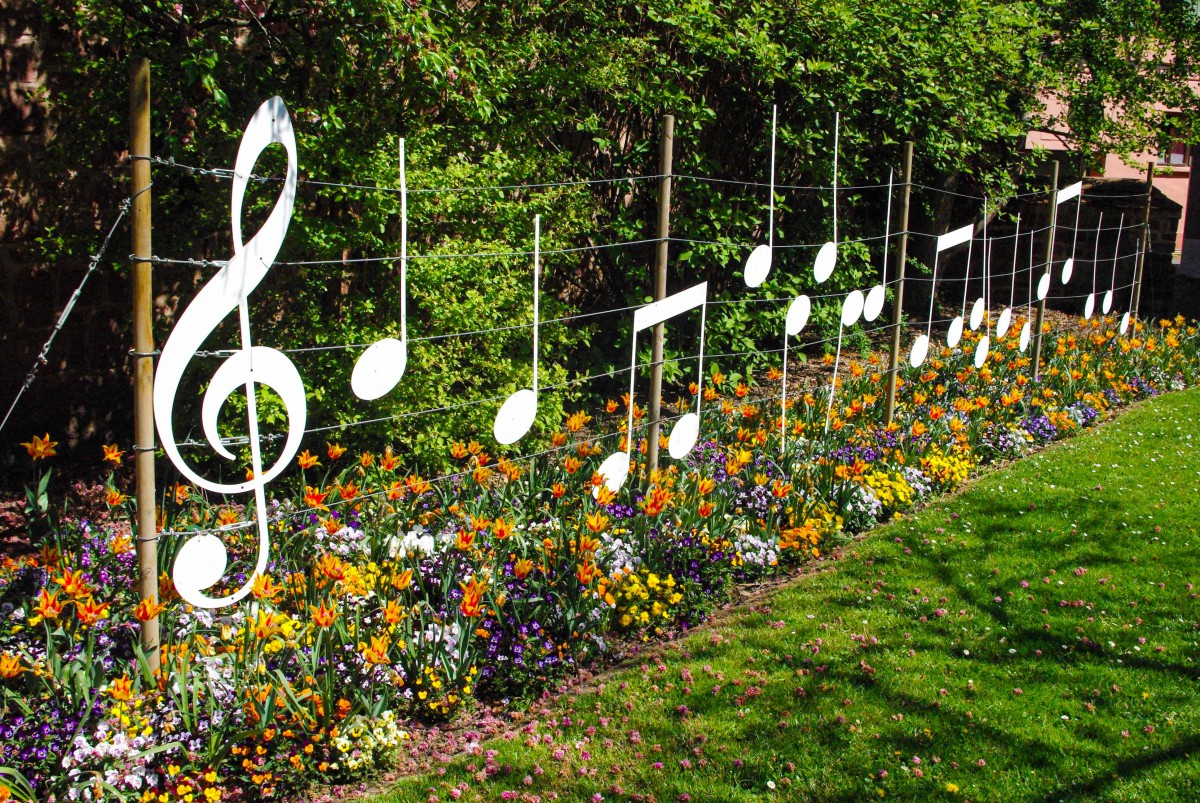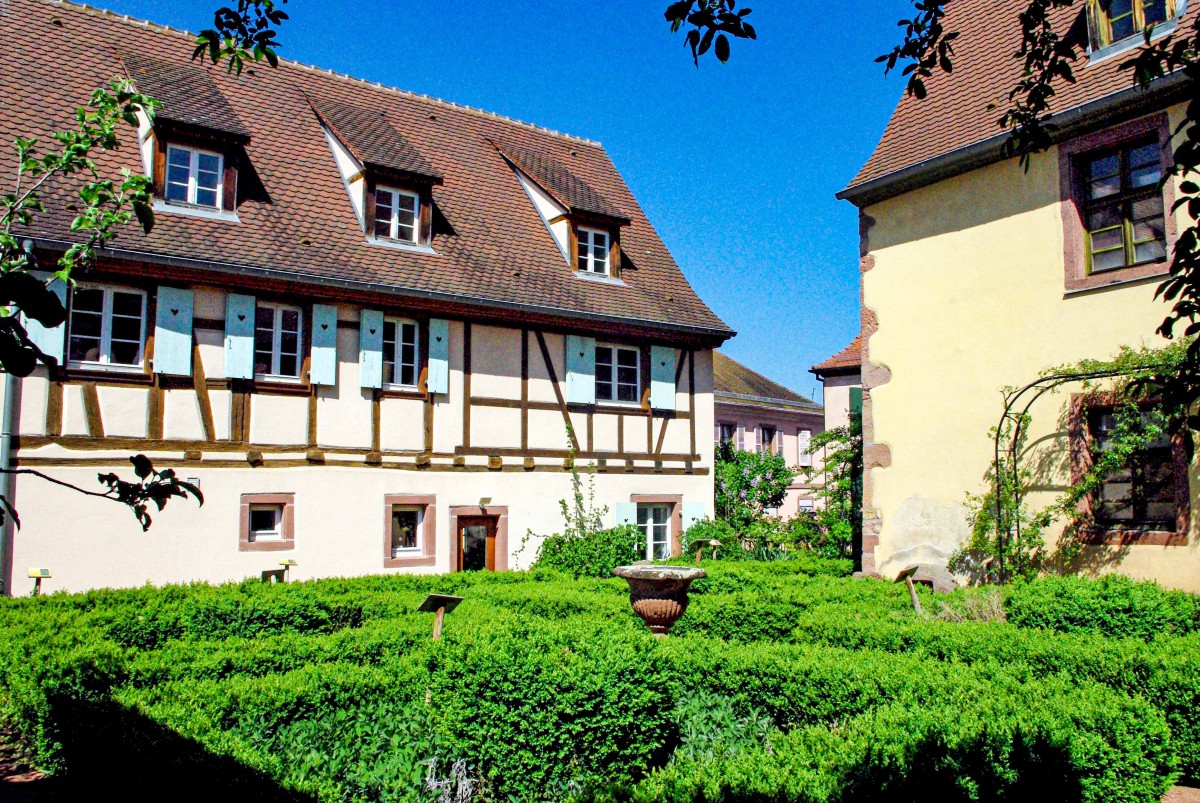The fortified village of Bergheim suddenly appears around a bend along the Alsace Wine Route. Bergheim occupies a beautiful landscape of undulating vine-covered hills and is famous for being one of the few towns in Alsace to have kept its medieval fortified walls intact.
The well-preserved centre of the village features some fine monuments and half-timbered houses. At the western entrance of the village, the imposing and turreted Obertor (Porte Haute), which dates back to the 14th century, is Bergheim’s only remaining gate. With its winding streets lined with wine-growers houses and wrought-iron signs, Bergheim has become an inevitable stop along the Alsace Wine Route.
In 2022, Bergheim won the prestigious title of “Village Préféré des Français” (the Favourite Village of the French).
History of Bergheim

As with many other Alsatian towns, Bergheim sprang up along a Roman trade route between Strasbourg and Lyon, the site having originally been inhabited during the Pax Romana.
Winegrowing in Bergheim is a long-established industry, dating back to the 10th century.
Bergheim in the Middle Ages
In the 12th century, Bergheim belonged to the counts of Eguisheim-Dabo. In 1225, Bergheim came under the tutelage of the Dukes of Lorraine before falling into the hands of the Ribeaupierre dynasty in 1287. The same year, Hartmann de Baldeckduring completely destroyed the village of Bergheim during the succession war of the Ribeaupierre.

In 1293, the army of King Adolf of Germany, the count of Nassau raged war against the Habsburgs, destroying the village and besieging the neighbouring Ortenbourg Castle.
In 1310, after the reconstruction of the village, Henri II of Ribeaupierre decided to fortify Bergheim. Two years later the coveted title of “City” was bestowed on the village by Henri VII of Luxembourg. The King also conferred upon Bergheim the right to grant asylum.
In 1313, the Ribeaupierres sold Bergheim to the Habsburgs along with the neighbouring villages of Rodern and Rorschwihr.

Austrian Bergheim
Thereafter Bergheim became a little fortified Austrian town next to the village of Saint-Hippolyte, the outpost of the Duke of Lorraine.
Bergheim did not however stay under Austria’s wing for long. A year later, the Habsburgs mortgaged Bergheim’s future to Henri of Mullenheim, a banker from Strasbourg.
In fact, the inhabitants of Bergheim bought back their independence themselves only to again come under the authority of the Habsburgs. The Austrian dynasty did not stop there. Each time they were in need of funds, Bergheim was mortgaged to:
- the Hattstatts in the 14th century,
- the count of Lüpfen and the Margrave of Basle in the 15th century, and
- the Ribeaupierres in the 16th century.
Each time, the people of Bergheim paid to recover their freedom.

Asylum granted!
For this reason, in 1375, Archduke Leopold II granted the little town the right to mint coins. He also confirmed its right to grant asylum. In the 16th and 17th centuries, the village of Bergheim received 752 applications for asylum. They included 728 for murder and serious injury and 24 for debts. The village granted 744 of them.
Audacious Lack’Mi
In 1534, a villager from Rodern was pursued for a crime and found refuge in Bergheim. Grateful, he installed on the Porte Haute the ‘Lack’Mi‘ (see photo). It is an allegorical bas-relief sculpture depicting a man making fun of the people who tried to arrest him (by sticking out his tongue while showing his bare bottom!)

In 1648, the town of Bergheim became French by virtue of the Treaty of Westphalia.
The fortifications of Bergheim

As one of the best examples of a fortified town in Alsace, two kilometres of ramparts surround the village of Bergheim. The fortifications are set out in a rectangular shape 600 m long and 300 m wide and spread over 18 hectares.
For obvious reasons, the northern front was provided with the best protection because people expected the enemy to come from this side.
Unlike other fortified towns in Alsace, Bergheim did not have a castle within or against its walls.

Four mighty gates were built on each of the four cardinal points: the Untertor to the East on the way to Sélestat, the Neutor to the South on the way to Guémar, the Obertor to the West on the way to Ribeauvillé, and the Leimentor to the North.
The Obertor
Only the Obertor (Porte Haute) still stands today. This gate dates back to 1310 and stands 22 metres high. The entrance was modified several times during the Middle Ages. The roof is covered with glazed tiles similar to the motives found in Burgundy.

The external façade is entirely rendered while the interior features half-timbering which makes it less austere. This is similar to the Dolder Gate in Riquewihr.
At one time, the gate was preceded by a barbican drawbridge.
A walk along the ramparts offers fine views over the hills, the well-kept double-fortifications, the Haut-Kœnigsbourg castle and the vineyards.

Visiting the village of Bergheim
From the car park next to the Obertor (Porte Haute), enter the historic part of town by walking under the gate.

Grand’Rue
Stroll down the Grand Rue which is lined with beautiful half-timbered houses and the old washhouse of the village. There, you can admire winegrowers’ houses with their carved timber and stone oriels, some of them highlighted by elegant wrought-iron signs.


Place du marché
Place du Marché is Bergheim’s largest square, lined by the Town-Hall and some charming half-timbered houses. On the square stands a fountain made of sandstone and wrought ironwork, on which is featured the coat of arms of Bergheim.


The church
The parish Catholic Church was built with red sandstone from the Vosges in the 14th century following a fire which burnt down the previous sanctuary. It underwent several modifications over time, particularly to the bell tower in the 18th century.

The narrow streets
You can walk in a few narrow streets to get a better idea of this typical flower-decked Alsatian village: rue de la Cigogne, rue des Chevaliers, and rue des Juifs where the presence of a synagogue dating back to 1862 reminds us that Bergheim used to house one of the largest Jewish communities in Alsace until the 20th century.

If you visit Bergheim in Spring, Summer or Autumn you’ll find it beautifully decorated with flowers, from geraniums on the window to bed-flowers.


The Witches’ House
Finally, a visit to Bergheim would not be complete without mentioning the Witches’ House (Maison des Sorcières). This little museum located at 5 rue de l’église records the lives of the women who were tortured, judged and burnt at the stake in Bergheim for alleged acts of witchery.

Find out more about Bergheim on the website of the Ribeauvillé-Riquewihr Tourist Office.
Pin it for later






Pierre,
I was fortunate enough to visit Bergheim almost three years ago with my daughter when we were in Alsace and I agree that it's a lovely village. I don't know how they were able to choose it as the Village Préféré des Français, however, because like Bergheim, so many of those villages are charming and full of history. We stayed in Riquewihr and visited many of the villages along the Route des Vins. Of the towns we visited, I'd have to say that Riquewihr and Eguisheim were our favorites. As usual, your article made me want to return and spend more time in this beautiful part of France! Merci!
Thank you Ellen. This is a very popular TV show in France that takes place every year. French people choose a village per region on the internet. And a grand finale reveals the one that received the most votes.
Pierre, Every Sunday I look forward to what surprises you will reveal this week.
I am always delighted to read about parts of France that I have never discovered.
I try to get to France every other year but since COVID I have not.
Thank you for all you do to bring France to us every week! Gérard Benoît
You’re most welcome Gérard! Always a pleasure 🙂
Superb as always!!!